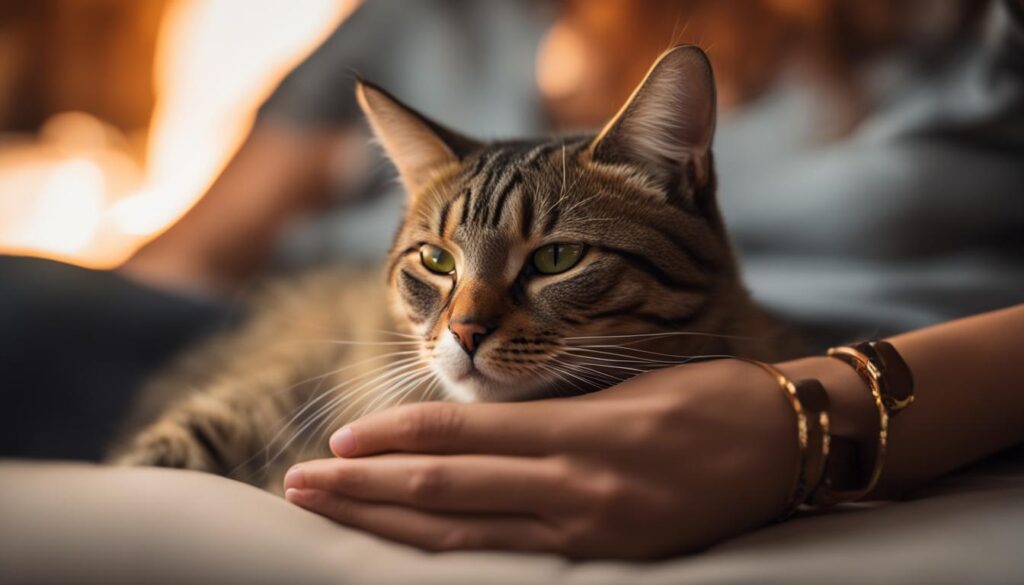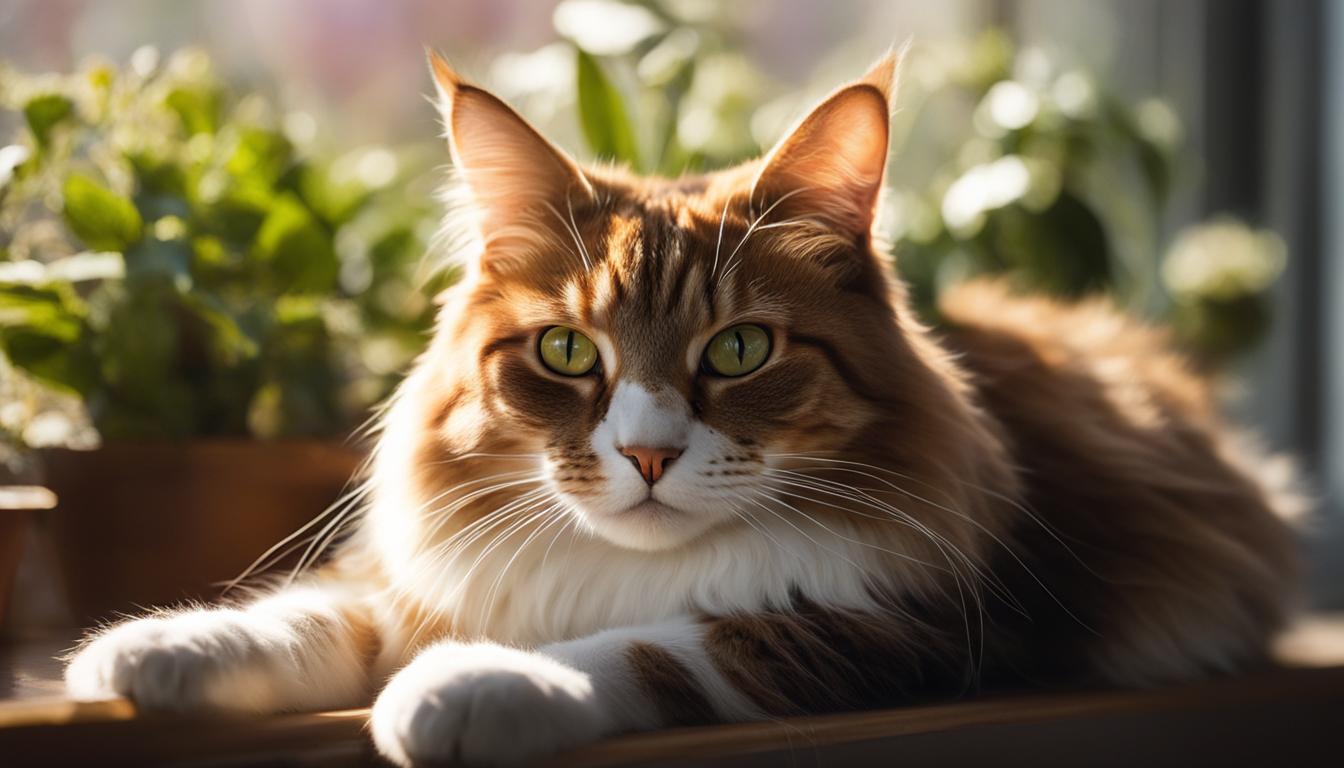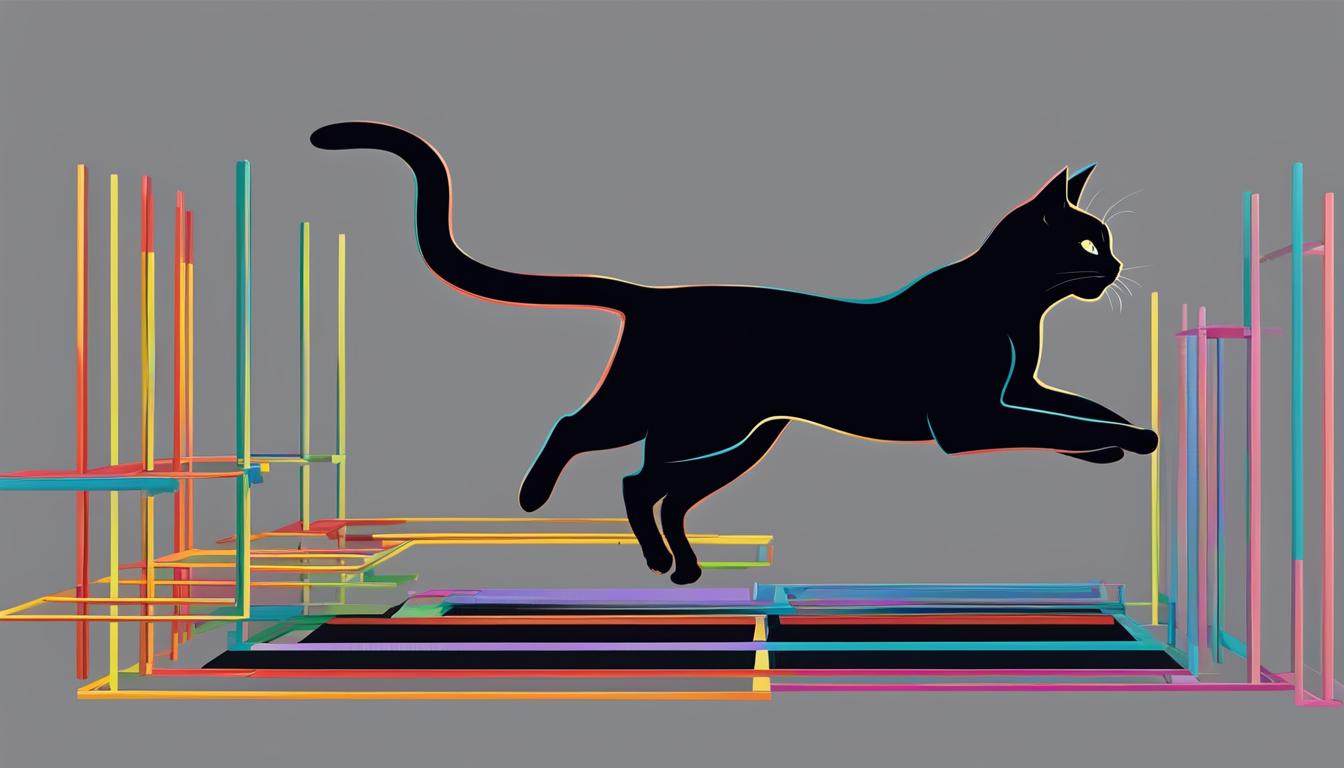Have you ever wondered why cats purr? It’s a fascinating subject that delves into the intricate biology of these enigmatic creatures. Purring is not just a simple sound of contentment; it holds the potential for communication, comfort, and even healing. Join me as we explore the mesmerizing world of a cat’s purr and unravel its secrets.
Key Takeaways:
- Cats purr through a complex process involving the larynx and neural oscillator in the brain.
- Purring is a form of communication and bonding between mother cats and kittens.
- Purring has been found to have potential healing properties, stimulating bone growth and promoting the healing process.
- Purring releases endorphins, providing emotional benefits and reducing stress for both cats and humans.
- Understanding the different contexts in which cats purr can help decipher their communication and emotional state.
The Many Reasons Cats Purr
When we think of a cat purring, we often associate it with happiness and contentment. While this is true, purring serves a variety of purposes beyond expressing joy. Cats are skilled communicators, and they use purring as a way to convey their needs and emotions to both other cats and humans.
One of the reasons cats purr is to communicate their happiness and contentment. When a cat is relaxed and comfortable, it often purrs to signal its content state. However, purring can also serve as a means of communication in other contexts. For example, a hungry cat may purr to let its owner know that it wants food or attention. Cats are clever creatures, and they have learned to use their purrs to get what they want!
Purring is not limited to positive emotions. Cats may also purr when they are stressed, anxious, or in pain. Purring can serve as a self-soothing mechanism for cats, helping them calm themselves down in times of distress. It can also act as a way for cats to seek comfort and reassurance from their owners. So, if you notice your cat purring when it seems upset, it may be a sign that it is seeking comfort.
The benefits of cat purring are not limited to feline companions. Research has shown that the sound of a purring cat can have positive effects on human emotions and well-being. The soothing vibrations produced by purring have been found to reduce stress levels and promote relaxation in humans. So, the next time you hear your cat purring, take a moment to appreciate the emotional benefits it brings to both of you!

Table: Different Contexts of Cat Purring
| Context | Explanation |
|---|---|
| Happiness and Contentment | Cats purr to express their pleasure and relaxation. |
| Communication | Cats use purring to convey their needs and desires to their owners. |
| Self-Soothing | Purring can help cats calm themselves down in times of stress or anxiety. |
| Seeking Comfort | Cats may purr to seek comfort and reassurance from their owners. |
The Healing Power of Purring
While the healing power of a cat’s purr is often considered a myth, ongoing studies have shed light on the potential therapeutic benefits of this soothing sound. Researchers have been studying the vibrations produced during purring and their effects on feline companions. Although further research is needed, the preliminary findings suggest that purring may indeed have healing properties.
One area of focus in studying cat purr vibrations is their impact on bone growth and fracture healing. The low-frequency vibrations generated during purring have been found to stimulate bone cells, promoting the regeneration of damaged tissue and potentially accelerating the healing process. This phenomenon has been observed in cats, raising the possibility of applying similar principles to human medicine.
| Healing Properties | Benefits |
|---|---|
| Bone Growth Stimulation | Potential for faster fracture healing |
| Pain Relief | Reduction in feline pain levels |
Additionally, purring has been associated with pain relief in cats. It is believed that the vibrations produced by purring may have a soothing effect on feline companions, potentially alleviating discomfort or pain. While it is important to note that purring alone should not be considered a substitute for proper veterinary care, it can be a comforting presence for cats during their healing process.
Just as purring provides comfort and reassurance to cats, it may also have the potential to provide therapeutic benefits for humans. Further research is needed to fully understand the mechanisms behind these healing properties and explore potential applications in human medicine.
As researchers delve deeper into the complexities of cat purring, it becomes increasingly clear that there is more to this sound than meets the eye. The healing power of purring, although still partially shrouded in mystery, offers promising avenues for future study and potential medical advancements.

Purring as a Bonding Mechanism
When it comes to cats, purring is more than just a sign of contentment. It serves as a powerful bonding mechanism, both between mother cats and their kittens and between cats and their human caretakers. Purring acts as a form of communication, allowing cats to express their comfort and reassurance.
For mother cats, purring plays a crucial role in their relationship with their kittens. By purring, a mother cat can signal her presence and location, providing a sense of security for her vulnerable offspring. The gentle vibrations of a mother cat’s purr can have a soothing effect on her kittens, promoting a bond that is essential for their development.
But cats don’t reserve their purring solely for their feline family members. They also use this vocalization to communicate with their human companions. Cats have a unique ability to embed a cry similar to that of a human infant’s cry within their purr. This clever adaptation triggers our nurturing instincts, prompting us to provide the care and attention that our feline friends seek.
By purring, cats can effectively communicate their needs and desires to their human caretakers. Whether they’re hungry, in need of affection, or simply seeking companionship, a cat’s purr serves as a powerful tool for connecting and bonding with their human counterparts.

The Psychological and Physical Benefits of Purring
Purring offers a range of psychological and physical benefits for both cats and humans. The soothing sound of a purring cat has been found to have a calming effect and can help to reduce stress levels. The rhythmic vibrations produced during purring create a comforting sensation that promotes relaxation and a sense of well-being. Research has shown that interacting with a purring cat can lower blood pressure and decrease the risk of cardiovascular diseases in humans, highlighting the positive impact that this simple act can have on our health.
Recording and analyzing cat purrs have provided valuable insights into their frequency range and patterns, further supporting the therapeutic potential of purring as a natural healing mechanism. By studying the characteristics of different purrs, researchers can gain a better understanding of how they contribute to emotional well-being and stress relief. This knowledge can then be applied to develop innovative therapeutic interventions for emotional and psychological disorders in both cats and humans.
“The sound of a purring cat is the epitome of tranquility. It instantly puts me at ease and melts away any tension or worries I may have. It’s like having a personal therapist on-demand, available whenever I need a moment of calm in my hectic day.” – Cat lover
The Emotional Benefits of Cat Purring
The emotional benefits of cat purring extend beyond stress reduction. The act of petting a purring cat releases endorphins in both the cat and the human, creating a positive emotional bond. Cats have a natural ability to recognize and respond to human emotions, and the soothing sound of their purr can provide comfort and companionship during difficult times. The presence of a purring cat can also alleviate feelings of loneliness and promote a sense of connection and belonging.
In conclusion, the psychological and physical benefits of cat purring are undeniable. From reducing stress and lowering blood pressure to promoting emotional well-being and companionship, the simple act of interacting with a purring cat can have a profound impact on our overall health and happiness. So the next time you hear your feline friend purring, embrace the moment and let yourself be enveloped by the soothing sound that brings both comfort and joy.
Cat Purring and Human Health

When it comes to cat purring, the benefits extend beyond our feline friends and can positively impact human health. Measuring the frequency of cat purring can provide valuable insights into the emotional state of cats and its potential therapeutic effects on humans. Research has shown that the vibrations produced during purring release endorphins, which can reduce stress and promote a sense of well-being.
Studies have indicated that cat ownership is associated with a lower risk of heart disease and stroke. The presence of a purring cat can create a calming environment that may help lower blood pressure and reduce the risk of cardiovascular diseases. The soothing sound of a purring cat has a calming effect on humans, promoting relaxation and reducing stress levels.
The vibrations produced during cat purring release endorphins, which can reduce stress and promote a sense of well-being.
Recording and analyzing cat purrs have provided valuable insights into the frequency range and patterns of purring. This research further supports the therapeutic potential of purring as a natural healing mechanism. By understanding the emotional benefits of cat purring and its impact on human health, we can appreciate the unique bond between humans and their purring feline companions.
Benefits of Cat Purring on Human Health:
- Reduces stress levels
- Promotes relaxation
- May lower blood pressure
- Reduces the risk of cardiovascular diseases
| Study | Findings |
|---|---|
| Research Study 1 | Ownership of cats is associated with a lower risk of heart disease and stroke. |
| Research Study 2 | The presence of a purring cat can create a calming environment, promoting relaxation and reducing stress levels. |
| Research Study 3 | Cat purring releases endorphins, which can reduce stress and promote a sense of well-being. |
Conclusion
As I wrap up this exploration into the biology of a cat’s purr, it becomes clear that purring is not just a simple sound of contentment. It is a complex mechanism that serves multiple purposes in a cat’s life.
First and foremost, purring is a means of communication and bonding. It allows mother cats to reassure their kittens and helps cats connect with their human caretakers. By incorporating a cry similar to that of a human infant’s cry within a purr, cats trigger our nurturing instincts and effectively communicate their needs or desires.
But purring also has remarkable effects on emotions and well-being. The sound of a purring cat can soothe us, reduce stress levels, and instill a sense of relaxation. Studies have even shown that cat owners have lower blood pressure and a reduced risk of cardiovascular diseases. The therapeutic potential of purring as a natural healing mechanism is undeniable.
While there is still much to uncover about the healing power of purring, evidence suggests that it stimulates bone growth and aids in the healing process. Purring releases endorphins, not only in cats but also in humans, providing emotional benefits and reducing stress levels.
In conclusion, understanding the biology and significance of a cat’s purr deepens our connection with these beloved feline companions. Their purrs serve as a language of love, comfort, and potential healing. So, the next time you hear your cat purring, take a moment to appreciate the wonders of nature and the bond you share.
FAQ
How does a cat purr?
Cats purr through a complex process involving the larynx and neural oscillator in the brain. Purring is a low-pitched sound that occurs during both exhales and inhales, with no interruption in between.
What does cat purring signify?
While purring is commonly associated with contentment, it can also serve as a form of communication and bonding between mother cats and their kittens.
Can purring heal wounds?
There is evidence to suggest that purring may have healing properties, stimulating bone growth and promoting the healing process for wounds and fractures.
Why do cats purr when they are not happy?
Purring can serve as a means of communication, signaling hunger or a desire for attention. Cats may also purr as a self-soothing mechanism in response to stress, fear, or pain.
How does purring benefit cats and humans emotionally?
Purring releases endorphins in both cats and humans, providing emotional benefits and reducing stress.
What is the role of purring in bonding between cats and humans?
Purring serves as a form of communication and reassurance, allowing cats to communicate their needs or desires, such as hunger or attention, to their human caretakers.
Can cat purring have therapeutic effects on humans?
Cat purring has demonstrated potential health benefits for humans, such as reducing stress levels, promoting relaxation, and even lowering the risk of heart disease and stroke.





